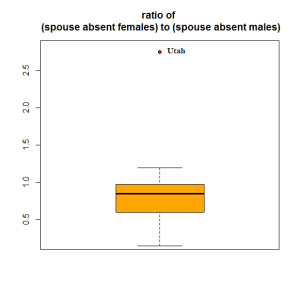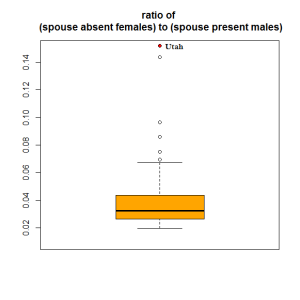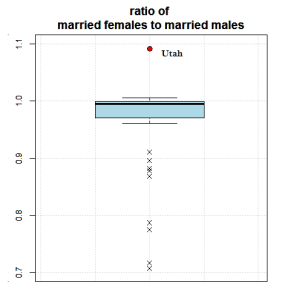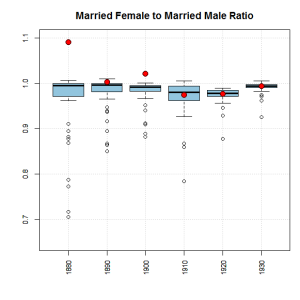Related Posts: Utah Polygamy and Divorce – 1880 to 1930; Divorce in 1890 Utah: Signs of Polygamy; Marriage in 1890 Utah: Very Normal
In this post I estimate the number of men and women living in polygamy in Utah in 1880 using data from the 1880 census and other sources.
I have estimated that in 1880 there approximately 9,000 persons in polygamous marriages in Utah. About 6,500 wives and 2,500 husbands. This is approximately 25% of married Mormon women and about 13% of married Mormon men. However, the total number could easily be closer to 10,000.
I also conclude that the census data by itself is not sufficient for estimating the number of persons living in polygamy. Other data is required. This conclusion is based on the fact that the married female to married male ratio for Utah from the 1880 and 1900 census’ were outliers. However, in 1890 it was nearly 1.0 (Figure 4), which means that in 1890 nearly all women in polygamous relationships were concealing their marital status, probably to protect their husbands and children. I believe that in the 1880 census nearly two thirds of women in polygamous relationships concealed their marital status.
These results should be qualified with polygamy studies from Utah’s earlier history. It is appears that during the 1860’s quite possibly more than 50% of married LDS women in Utah were polygamous wives.
Some background
I estimate that there were about 25,672 married (monogamous and polygamous) LDS women and about 19,313 married (monogamous and polygamous) LDS men in Utah in 1880. See the end of the post for the calculation. The percentages I estimate are based on these two numbers.
As with other types of analysis using census data I compare only the white population of Utah to the white population of the rest of the United States.
High estimates
Before proceeding some background information is necessary. In the book Fertility Change on the American Frontier: Adaptation and Innovation Bean et. al. analyzed marriage types from a sample of 86,721 Utah women born between 1800 and 1899. From this sample they found that 5,481 had been in polygamous relationships. From their data it appears that the peak of plural marrying was among those who were born between 1830 and 1855. If we assume an average marriage age of 20 then the peak of polygamous marrying occurred from 1850 to 1875. Again, assuming an average marriage of 20 their data indicates that by 1870 about 75.5% of all female polygamous marriages had occurred. And by 1880 (with only 10 years of polygamy left) about 92%. This suggests that by 1880 about 92% of all plural marriages in Utah’s history were extant.
The essay Plural Marriage and Families in Early Utah from lds.org indicates that by 1870 about 25-30% of the population lived in polygamous households. The 1870 US Census indicates 17,210 families in Utah. So 25-30% comes out to be 4,302 to 5,163 polygamous families. If we assume one polygamous wife per family then there are as many polygamous wives. If this is 75.5% of the total number of plural wives then using the higher number of 5,163 I get an estimate of about 6,838 polygamous wives in Utah’s history. Assuming 2.6 wives per husband we get 2,630 polygamous husbands for Utah’s history for a grand total of 9,468 persons in a plural marriage. (See “Men living in polygamy” below for details on the estimate of 2.6 wives per husband.)
This gives a rough estimate of between 9,000 to 10,000 persons in plural marriages in Utah during the 19th century.
If 92% of these marriages were extant by 1880 then we have roughly 7,300 to 9,200 persons in plural marriages: 5,300 to 6,500 women and 2,000 to 2,600 men. Naturally these are rough estimates.
In 1882 the US Congress pass the Edmunds Act which disfranchised all voters in Utah who were in plural marriages. This law was enforced by the Utah Commission. Their report from 1884, The Edmunds Act, Reports of the Commission, Rules, Regulations and Decisions (downloadable from Internet Archive) lists their efforts to disfranchise polygamous voters. Their report to Congress indicates that in the election of 1882 “about 12,000 men and women are excluded from registration by reason of polygamy” (p. 9). Their own detailed report indicates 6,282 were disfranchised (mostly due to polygamy), 424 had died, and 2,792 were removed from the previous voter register because they did not appear for registration. The 2,792 were apparently persons who had moved or were polygamists who didn’t try to register. Excluding those who were dead gives a total of 9,074 disfranchised persons.
[color-box]Note: For the 1883 election the Utah Commission bragged that nearly 15,000 LDS voters had been disfranchised, The Edmunds Act, Reports of the Commission, Rules, Regulations and Decisions, p. 109[/color-box]
Taking 9,000 to be the total number of polygamist in Utah in 1882 and assuming 2.6 wives for each polygamous husband we get an estimate of 6,500 polygamous wives and 2,500 polygamist husbands.
From estimates based on census data (below) about 2,290 polygamous wives can be accounted from the 1880 Census. This number is about 2.8 times lower than my estimate of 6,500. This means that the number of married LDS women in Utah estimated from the census data is low by about 4,210 persons.
Estimates from the census data
First, assume that were it not for polygamy the number of married women in Utah would be equal to the number of married men. This is a reasonable assumption owing to the fact that the married female to married male ratio for the US states and territories has a median value very near 1, and Utah’s male to female ratio is 1.08. (See Figure 4 for the married female to married male ratios of US states and territories; Utah is an outlier for 1880 and 1900.)
According to the IPUMS database Utah had 23,130 married males and married 25,241 females in Utah (from their 1880 complete count data set).
This means that about 2,111 polygamous wives can be accounted for in the census data using this method.
Shown below are three more census based estimates. They all produce similar numbers: 2,306; 2,622; and 2,120. Because the estimates are so similar they don’t provide any additional insight. However, they do illustrate in different ways that Utah is an outlier when it comes to marriage.
Spouse absent ratios
The 1880 census contains information on the usual marital categories: married, single, widowed, and divorced. It also includes information on if a spouse was present or absent in the household. So next I consider the male/female spouse absent ratios.
A standard belief about polygamous living conditions is that most polygamous wives had their own household. If this was true then polygamous wives would likely report their husband as absent. However, a polygamous husband would likely be living with one of his wives so he would report himself as married with his spouse present.
Figure 1 below shows a boxplot of the spouse absent female to spouse absent male ratios for US states and territories. That is,
sa = mfsa / mmsa, (eq. 1a)
where sa is the spouse absent ratio, mfsa is the number of married females reporting their spouses absent, and mmsa is the number of married males reporting their spouses absent. For Utah this equation is
sa.ut = mfsa.ut/mmsa.ut. (eq. 1b)

It is obvious from Figure 1 that Utah really stands out from the rest of the country.
If we assume that were it not for polygamy the sa ratio for Utah would be equal to the national median we get the following equation
sa.usm = mfsa.ut’/mmsa.ut, (eq. 2)
where sa.usm is the median sa ratio for the US, mfsa.ut’ is the number of married females reporting their spouse absent if Utah had an sa ratio equal to the national median, and mmsa.ut is the number of married males in Utah reporting their spouses absent. (I’m assuming mmsa.ut is unaffected.)
Subtracting eq. 2 from eq. 1b we get
(sa.ut – sa.usm) = (mfsa.ut – mfsa.ut’)/mmsa.ut,
Solving for (mfsa.ut – mfsa.ut’) gives an estimate of the number of polygamous wives.
From this we get 2,306 polygamous wives found in the census data using this method.
Spouse absent spouse present ratio
We can do a similar calculation using the spouse absent female to spouse present male ratio shown in Figure 2 below.

From this we get an estimate of 2,622 polygamous wives found in the census data.
Married female to married male ratio

Figure 3 above is a boxplot of the married female to married male ratios for the US. As you can see Utah has an unusually high number of married females when compared to married males. Let us assume that were it not for polygamy Utah would have a married female to married male ratio equal to 1. Note that the national median is very nearly equal to 1 and the male to female ratio for Utah is 1.08. We also assume the number of married males is unaffected by polygamy. We get the following two equations.
mf.ut/mm.ut = mr.ut (eq. 4)
mf.ut’/mm.ut = 1 (eq. 5)
where mf.ut is the number of married females in Utah, mm.ut is the number of married males in Utah, mr.ut is the married female to married male ratio for Utah, and mf.ut’ is the number of married females in Utah if mr.ut were to equal 1. Subtract eq. 5 from eq. 4 to get
(mf.ut – mf.ut’)/mm.ut = (mr.ut – 1),
where (mf.ut – mf.ut’) estimates the number of polygamous wives.
From this we get 2,120 polygamous wives in the census data using this method.
Average number
The average the four above estimates is 2,290 polygamous wives that can be accounted for in the census data.
Men living in polygamy
Utah historian Stanly Ivins estimated 66.3% of polygamous men had two wives, 21.2% has three wives, 6.7% has four wives and the remaining 6.1% had five or more. So the following equation should hold.
pm*0.67*2 + pm*0.212*3 + pm*0.067*4 + pm*0.061*m = pw,
where pm is the number of men living in polygamy, pw is the number of women in polygamy, and m is the average number of wives of polygamous men who married more than four women.
Solving this for pm we get
pm = pw/(0.67*2 + 0.212*3 + 0.067*4 + 0.061*m).
This equation gives an average of 2.6 wives per polygamous husband.
From the estimates shown at the end of this post I calculate that there were approximately 25,672 married LDS women and 19,313 married LDS men in Utah. And for reference an estimate of 6,500 polygamous wives and 2,500 polygamous husbands as already given above.
The church population at the time was 133,628, so this comes to about 7% of the LDS Church population involved with polygamy, at least. (This does not account for polygamists living outside Utah, but their numbers were probably small and wont affect a rough estimate much.)
Other estimates
During the Smoot hearings a church official testified that in 1890 there were 2,451 polygamous families.(*) Assuming one polygamous husband for each family then we have 6,372 polygamous wives (assuming 2.6 wives per husband) and about 8,823 persons in plural marriages.
In 1885 the First Presidency announced that about 2% of the entire church was involved with polygamy.(*) If “involved” means through marriage then this percentage much too low.
Leonard Arrington and Davis Bitton estimated that for the period from 1850 to 1890 about 12% of married women were involved with polygamy. They also estimated that no more than 5% of married men were polygamous. Both estimates are close to my census based estimates. William E. Berrett estimated that 2% of the adult male population had more than one wife, which is also much lower than what I calculated.(*)
Utah historian Stanly Ivins estimated that “there may have been a time when fifteen, or possible twenty, percent of the Mormon families of Utah were polygamous.” Note that Ivin’s percentages are based on a sample of 1,784 polygamous men. His percentages seem low to me. (I don’t know the time period of his sample.)
For estimates from Utah’s earlier history Cornwall et. al. found that in 1860 for three wards in Salt Lake Valley about 56% of married women were in polygamous relationships. Their analysis is based on a sample of 534 women, a small sample, about 0.9% of the Mormon population. But it does appear that Mormon plural marriages were much more common in the early period of Utah’s history. Ivins reported that “the rate of polygamous marrying dropped in 1858 to less than a third and in 1859 to less than a fifth of what is was in 1857. This decline continued until 1862…” He also reported a short-lived acceleration in 1868 and 1869 and another revival in 1884 and 1885. Also, as immigration of converts increased the proportion of polygamous wives would naturally decrease over time.
Bean et. al. analyzed 86,721 married Utah women who had been born outside of Utah from 1800 to 1899. Of this they found 5,481 had been in a polygamous relationship during their lifetime, which is about 6% of their sample. However, Cornwall et. al. points out that the Bean et. al. data “indicate that between 27 and 31 percent of women born in 1830 through 1844 were married to a polygamous husband during their lifetime. These women would have been of marriageable age between 1848 and 1862…” For example, Bean et. al. shows that 23% women in Utah born between 1835 and 1839 were polygamous wives (see Bean et. al., Table 11, p. 94-95).
Final thoughts
If we look at the married female to married male ratios from the US Census from 1880, 1890, 1900, 1910, 1920, and 1930 we can see that in 1880 and 1900 Utah is an outlier. But for 1890 it is not. I attribute this to the anti-polygamy measures applied by the federal government. These measures became severe during the 1880’s culminating in the 1890 LDS Church Manifesto officially renouncing the practice of polygamy. (See Morrill Anti-bigamy Act (1862); Edmunds Act (1882); Edmunds-Tucker Act (1887); Idaho Test Oath (1884-85).) Given that census data is self-reported polygamous wives in 1890 were probably “underground” about their marital status in order to protect their husbands and families. The married female to married male ratio was about 1.0 indicating that nearly all polygamous wives in 1890 concealed their marital status. I believe this was also the tendency in 1880. As many as two thirds did not report their marital status.
(This also means that my post Marriage in 1890 Utah: Very Normal contains some misleading conclusions. I have added a note at the beginning of that post to alert readers to this fact!)

I don’t believe the census data alone is an accurate way to estimate the number of plural marriages. In doing this post I feel comfortable with my estimate of 12% of married men and 25% of married women in polygamy around 1880. But these numbers should be taken only as rough (emphasis) estimates.
References
References marked with a (*) are based on information from the Cornwall, Courtright, and Beek paper cited below.
Marie Cornwall, Camela Courtright, and Laga Van Beek, “How Common the Principle? Women as Plural Wives in 1860,” Dialogue: A Journal of Mormon Thought 26 (Summer 1993): 149 <http://www.dialoguejournal.com/wp-content/uploads/sbi/articles/Dialogue_V26N02_153.pdf, accessed 20150702>
Stanley S. Ivins, “Notes on Mormon Polygamy,” Western Humanities Review 10, no. 3 (Summer 1956): 233 <https://apushbystrunc.wikispaces.com/file/view/Notes+on+Mormon+Polygamy.PDF, accessed 20150702>
Leonard J. Arrington and Davis Bitton, The Mormon Experience: A History of the Latter-day Saints (Boston, 1979), 1999.
Lee L. Bean, Geraldine P. Mineau, and Douglas L. Anderson, Fertility Change on the American Frontier: Adaptation and Innovation (Berkeley: University of California Press, 1990).
1880 Census Data, IPUMS-USA, University of Minnesota, www.ipums.org.
Note: The 1880 IPUMS dataset was developed through a collaboration between the Minnesota Population Center and the Church of Latter-day Saints; these complete count data have been available since 2008.
Note: The LDS magazine Millennial Star reported that the 1880 census counted 120,283 Mormons; 14,156 Gentiles; 6,988 Apostates; 820 Josephites; and 1,716 doubtful in Utah. From these numbers 83.5% of the territory was LDS. (Millennial Star, vol. 44, No. 40, p. 639, <http://contentdm.lib.byu.edu/cdm/ref/collection/MStar/id/5621 accessed 20150705>
Estimating the number of married Mormon women in Utah
Percent of LDS: 83.5% of Utah residents were LDS. (Millennial Star, vol. 44, No. 40, p. 639.)
White married men in Utah: 23,130 (source 1880 census from IPUMS)
White married women in Utah: 25,250 (source 1880 census IPUMS)
White Utah population: 141,279 (source 1880 census IPUMS), 83.5% of which is LDS.
Steps to estimate the number of married Mormon women in Utah.
(1) Estimate of the number of polygamous women in Utah that can be accounted for from the census data.
(2) Subtract (1) from the number of married women in Utah.
(3) Assume that 83.5% of (2) are LDS. This is an estimate of the number of monogamous LDS women in Utah.
(4) Add the estimated number of women in polygamous relationships to (3) to get the total number of married LDS women in Utah.
There are 2,290 polygamous wives that can be accounted for in the census data and 25,250 married women. This gives 22,960 who were monogamous. If 83.5% percent of these are LDS we have 19,172 monogamous LDS women in Utah. Adding the 2,290 polygamous wives back into this estimate gives 21,462 married LDS women found in the census data. Adding an additional 4,210 polygamous wives estimated from the Utah Commission data gives a total of 25,672 married LDS women in Utah.
According to the census there were 23,130 married men in Utah. I assume that men did not conceal their marital status (their first marriage was legal and the number of married men in Utah does not stand out; see Marriage in 1890 Utah: Very Normal). 83.5% of them are LDS which comes to 19,313 married LDS men.
Campbell, Eugene E., and Bruce L. Campbell. “Divorce Among Mormon Polygamists: Extent and Explanations.” Utah Historical Quarterly 46 (Winter 1978):4-23.
This paper estimates the number of men practicing polygamy in 1885 as 2,400. This is very close to my estimate of 2,500 in 1880.
The footnote reads “B. H. Roberts, A Comprehensive History of the Church of Jesus Christ of Latter-day Saints, Century I, 6 vols. (Salt Lake City: Deseret News Press, 1930), 6:149, who ‘estimates that male members practicing polygamy represented only 2% of church population,’ which was about 120,000 in 1888.”
The paper is available here, accessed 20150821.